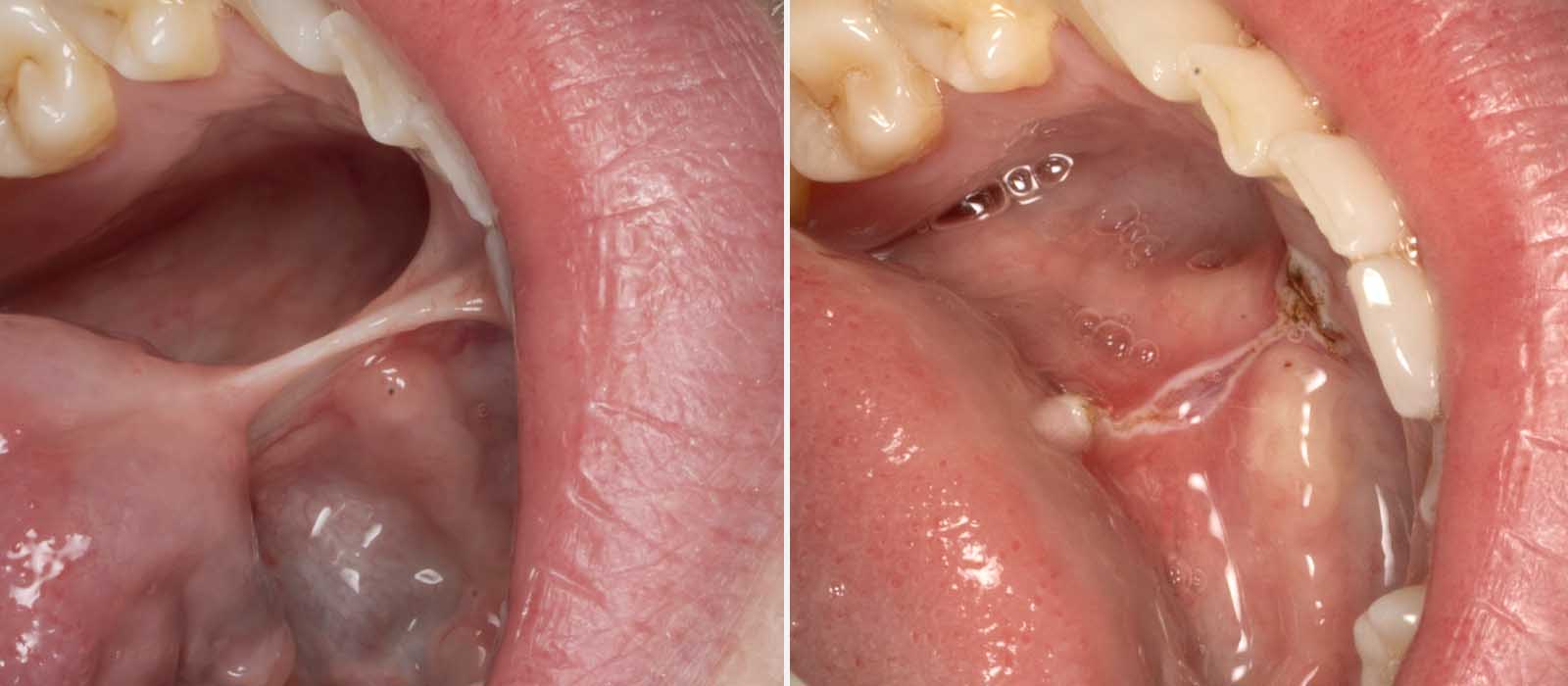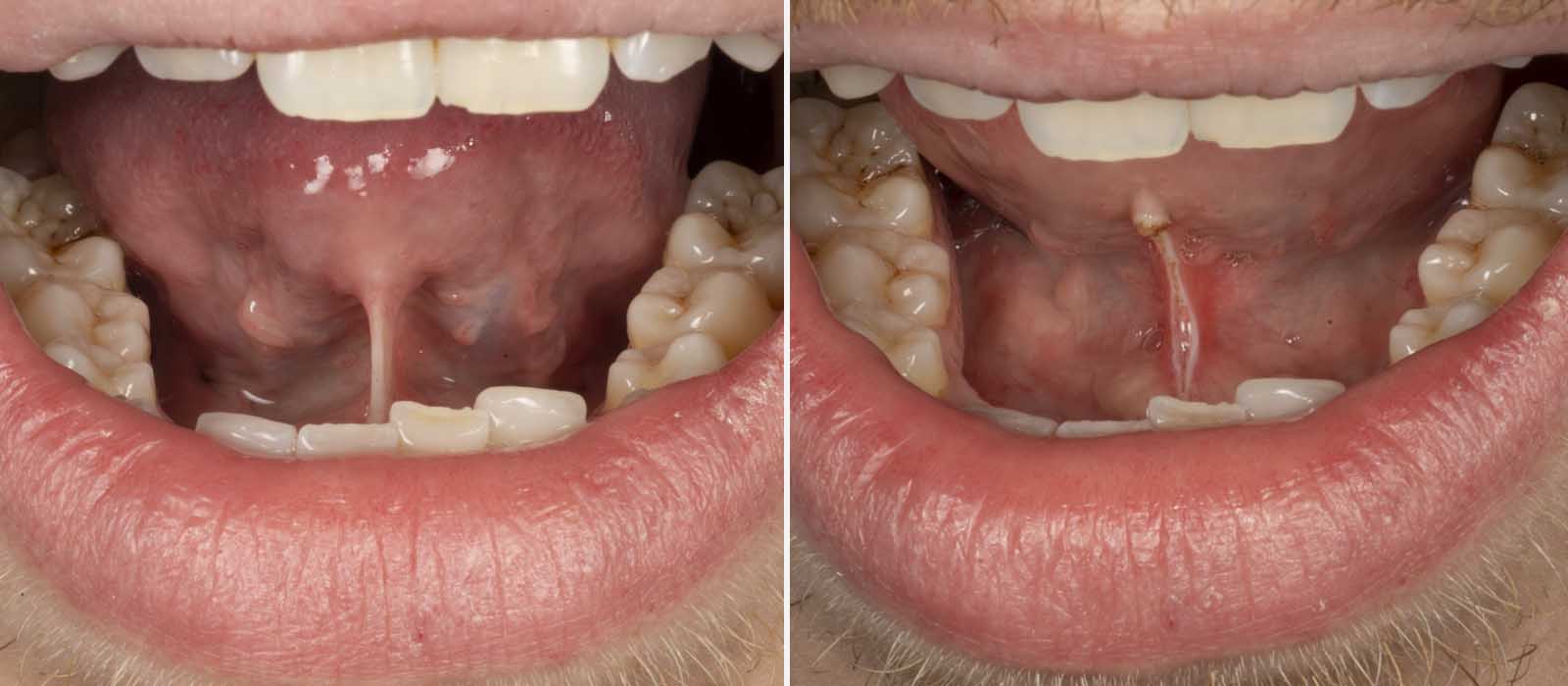Frenectomy
A frenectomy, also known as a frenulectomy, is an oral surgery used to treat lip-tie or tongue-tie. During this procedure, a doctor removes or alters a band of connective tissue called a frenum or frenulum, which connects two parts of the body. In the mouth, a frenum may connect the lips to the gums or the tongue to the floor of the mouth.
There are multiple frena in the mouth, and they typically do not cause any issues. However, if a frenum is too short or tight, it can lead to oral health problems and difficulties with speech.
Release of lip and tongue ties (Frenectomies) is currently available from our Gold Coast dental clinic in Nerang.

Adults With Ankyloglossia
Tongue-tie in Adults
Tongue-tie, or ankyloglossia, occurs when the lingual frenulum is too short, thick, or tight, limiting tongue movement in adults. Though often diagnosed in childhood, many adults experience untreated tongue-tie, leading to various challenges.
Common issues include speech difficulties, as restricted tongue movement makes it hard to articulate sounds like “l,” “r,” “t,” and “s,” which can affect communication in personal and professional settings. Oral hygiene can also suffer, increasing the risk of plaque, cavities, and gum disease. Additionally, eating can become difficult, potentially leading to nutritional issues.
Due to these challenges, social and psychological effects, such as lowered self-esteem and anxiety, may arise. Treatment options for adults include a frenectomy—a minor surgical procedure to release the frenulum—and speech therapy or oral exercises for those with milder symptoms. Consulting healthcare professionals is essential to determine the best individualised treatment plan. Addressing tongue-tie can significantly improve communication, oral health, and quality of life.
Teens With Ankyloglossia
Tongue-tie in Teenagers
Tongue-tie, or ankyloglossia, in teenagers occurs when the frenulum, the tissue connecting the tongue to the floor of the mouth, is short, thick, or tight, limiting tongue movement. While often noticed in babies, tongue-tie can persist into adolescence and cause various issues.
One major problem is speech difficulties. A restricted tongue can make it hard to say sounds like “l,” “r,” and “s,” which can affect a teen’s confidence in communication. These issues may become more noticeable as clear speech is required for public speaking or singing.
Tongue-tie can also complicate oral hygiene and dental health. Limited movement can make it hard to clean teeth properly, increasing the risk of cavities and gum disease. Some teens might develop gaps or jaw alignment issues between their lower front teeth.
Eating can also be challenging for those with tongue-tie. Teens may struggle with foods that require more tongue movement or find swallowing uncomfortable.
Treatment options are available for teens with significant issues. A frenectomy, a minor surgery to cut the frenulum, can improve tongue mobility and is usually done under local anesthesia with a quick recovery. Many see immediate improvements in speech and comfort after the procedure.
Teens with mild symptoms may benefit from speech therapy or exercises instead of surgery. Consulting a speech therapist, dentist, or oral surgeon can help determine the best approach.
Addressing tongue-tie can significantly improve a teenager’s quality of life, enhancing confidence and oral health.
Infants With Ankyloglossia
Tongue-tie in babies
Tongue-tie, or ankyloglossia, is a condition present at birth where the band of tissue under the tongue, called the lingual frenulum, is too short or tight. This can limit tongue movement, affecting feeding, swallowing, and later speech.
Babies with tongue-tie may struggle to latch during breastfeeding, leading to inadequate milk intake, longer feeding times, and discomfort for the mother. Some infants may not gain enough weight or have other symptoms, like a heart-shaped tongue tip when crying.
The severity of tongue tie varies. Some babies may not have many issues, while others might face more significant challenges. Often, treatment isn’t needed, as babies may adapt or the frenulum may stretch naturally.
If the condition significantly impacts feeding or speech, a simple surgery called a frenectomy or frenotomy may be recommended. This involves cutting the frenulum to improve tongue movement. The procedure is quick, usually done in a doctor’s office, and most babies see improvement in feeding afterwards.
Parents concerned about tongue-tie should consult a pediatrician or lactation consultant to evaluate their baby’s feeding and frenulum appearance. Early identification and treatment can help prevent feeding difficulties and support healthy growth.
Benefits of a Frenectomy
Overall, a frenectomy can significantly improve oral health, comfort, and quality of life. A frenectomy offers several benefits for individuals with a restrictive frenulum affecting oral function, speech, or comfort:
- Improved Oral Function: Enhances tongue and lip mobility, aiding in speech, eating, and swallowing.
- Better Speech Clarity: Helps with the articulation of sounds, improving communication skills and confidence.
- Easier Feeding: Facilitates effective breastfeeding in infants and improves eating and swallowing for all ages.
- Enhanced Oral Hygiene: Allows for easier cleaning of teeth and gums, reducing the risk of cavities, gum disease, and bad breath.
- Increased Comfort: Alleviates pain and tension associated with a tight frenulum, reducing the risk of oral injuries.
- Improved Fit for Dental Appliances: Enhances comfort and fit for dentures, braces, and other oral devices.
- Quick and Simple Procedure: Minimally invasive with a short recovery time.
FAQ’s
Who has to get a frenectomy?
A frenectomy, a minor surgical procedure to remove or modify the frenulum (the small fold of tissue connecting the tongue to the floor of the mouth or the lips to the gums), is recommended for individuals experiencing significant issues due to a tight or restrictive frenulum. The decision to undergo a frenectomy depends on the severity of the condition and the specific problems it causes.
Here are some situations where a frenectomy might be necessary:
1. Infants with Feeding Difficulties:
Tongue-Tie (Ankyloglossia)
If a baby has difficulty breastfeeding due to tongue-tie, which restricts tongue movement, a frenectomy may be recommended. The condition can make it hard for the baby to latch correctly, leading to inadequate milk intake, prolonged feeding times, and pain for the breastfeeding mother. In such cases, a frenectomy can improve the baby’s ability to feed effectively.
Lip-Tie
Similarly, if the upper lip frenulum is too tight (lip-tie), it can interfere with proper breastfeeding. A frenectomy can help release the lip and improve feeding.
2. Children with Speech Impediments:
Children with a restrictive frenulum may experience difficulties in speech development, particularly with the articulation of certain sounds (like “l,” “r,” “t,” “d,” “z,” “s,” “th,” and “n”). If speech therapy alone cannot address these issues, a frenectomy may be considered to improve tongue mobility and speech clarity.
3. Teens and Adults with Lingual or Labial Restrictions:
Speech or Swallowing Difficulties
A tight frenulum can cause ongoing speech difficulties or challenges with swallowing in teens and adults. If these issues interfere with daily life or professional communication, a frenectomy might be recommended.
Oral Hygiene and Dental Health
A restricted frenulum can make it difficult to clean the mouth properly, leading to oral health problems like cavities, gum disease, or bad breath. If the frenulum contributes to these issues, a frenectomy could be beneficial.
Eating and Comfort
A frenectomy may be necessary to improve oral function if a tight frenulum affects the ability to chew or swallow certain foods comfortably or causes discomfort when eating.
4. Individuals with Orthodontic or Prosthetic Needs:
Orthodontic Treatment
In some cases, a tight frenulum can affect orthodontic treatment or tooth positioning, particularly if it creates tension that pulls the teeth or gums. A frenectomy might be part of an orthodontic treatment plan to ensure better alignment and function.
Prosthetic Fitting
For individuals requiring dentures or other oral prosthetics, a frenulum that is too tight or positioned unfavorably can interfere with the fit and comfort of the prosthetic. A frenectomy may be recommended to improve the fit.
5. Adults Experiencing Pain or Discomfort:
Adults who experience chronic discomfort or pain due to a restrictive frenulum, such as tension in the tongue, jaw, or surrounding muscles, may benefit from a frenectomy to relieve these symptoms.
What kinds of frenectomies are there?
Frenectomies target different types of frenula in the mouth to resolve specific issues. Here are the main types:
- Lingual Frenectomy: Treats tongue-tie by cutting the tight lingual frenulum, improving tongue mobility and addressing feeding or speech difficulties.
- Labial Frenectomy: Addresses a tight labial frenulum that connects the lip to the gums, preventing issues like gaps between teeth and discomfort.
- Buccal Frenectomy: Targets the buccal frenulum near the molars, alleviating tension that affects speech and comfort with dentures.
Techniques:
- Traditional Surgical: Involves scissors or a scalpel and may require sutures.
- Laser: Offers precise cuts with minimal bleeding and faster recovery.
- Electrocautery: Uses heated instruments for precise cuts and reduced bleeding.
The choice of frenectomy is based on the specific problem and anatomy, determined by a healthcare professional. These procedures are safe and can significantly improve oral function and comfort.
What happens during this process?
Frenectomy Overview
A frenectomy is a minor surgical procedure that removes or modifies the frenulum, the tissue connecting parts of the mouth, to improve tongue or lip mobility.
Procedure Steps
1. Pre-Procedure Preparation:
- Assessment and Consultation: A healthcare provider (dentist, pediatrician, or oral surgeon) examines the frenulum and discusses the need for the procedure, including benefits, risks, and alternatives.
- Informed Consent: The patient or guardians consent after understanding the procedure and its implications.
- Anesthesia Administration: Local anesthesia is typically used, with topical numbing for infants and potential sedation for young children or anxious patients.
2. During the Procedure:
- Positioning: The patient is positioned comfortably.
- Frenulum Exposure: The provider lifts the lips, tongue, or cheeks to access the frenulum.
- Cutting or Modifying the Frenulum:
- Traditional Surgical Technique: Surgical scissors or a scalpel cut the frenulum, sometimes requiring sutures.
- Laser Technique: A laser cuts the frenulum, minimising bleeding and discomfort, often without sutures.
- Electrocautery Technique: An electrocautery device uses heat to cut the frenulum, reducing bleeding and infection risks.
3. Post-Procedure Care:
- Immediate Aftercare: The provider checks for bleeding or complications. Patients are monitored for comfort and reactions to anesthesia.
- Instructions for Recovery: Eating, drinking, and oral hygiene guidelines are provided. Breastfeeding can typically resume immediately for infants. Pain relief options include over-the-counter medications for older children and adults.
- Exercises: Recommended to prevent reattachment and promote healing.
4. Follow-Up:
A follow-up appointment ensures proper healing and addresses concerns.
Expected Outcomes
Recovery is usually quick, especially with laser or electrocautery methods. Patients typically notice improvements in oral function shortly after the procedure. While complications are rare, they can include minor bleeding or reattachment if aftercare is not followed. Overall, frenectomies are safe and effective for those with functional limitations due to a restrictive frenulum.
What are the Pros and Cons of a frenectomy?
A frenectomy is a minor surgical procedure that removes or modifies a frenulum—the tissue connecting parts of the mouth. Here are the key pros and cons:
Pros:
- Improved Oral Function: Enhances mobility for better speech and breastfeeding.
- Better Oral Hygiene: Increases mouth cleaning effectiveness, reducing cavities and gum disease risk.
- Enhanced Comfort: Relieves pain associated with a tight frenulum.
- Easier Eating and Swallowing: Reduces discomfort and choking risks.
- Quick Recovery: Minimally invasive with a fast return to normal activities.
- Long-Term Benefits: Prevents future speech and hygiene issues.
Cons:
- Risk of Complications: Rare risks include bleeding and infection.
- Post-Procedure Discomfort: Mild pain is possible post-surgery.
- Need for Follow-Up Care: Requires exercises to avoid complications.
- Not Always Needed: May not be necessary if the frenulum doesn’t cause issues.
- Cost and Accessibility: Costs might not be fully covered by insurance.
- Psychological Impact: Surgery can cause anxiety, particularly in children.
In summary, a frenectomy can greatly benefit those with restrictions due to a tight frenulum, but it’s important to consult a healthcare professional to weigh the risks and benefits.
What’s the difference Frenotomy vs. frenectomy?
A frenotomy and a frenectomy are surgical procedures used to address issues with the frenulum, but they differ in extent and technique.
Frenotomy:
- Involves a small cut in the frenulum (either lingual or labial) to release tension and improve mobility without removing tissue.
- Typically used for mild cases of tongue-tie or lip-tie.
- Usually quick, performed in a doctor’s or dentist’s office with minimal anesthesia, especially for infants.
- Recovery is fast with minimal discomfort or bleeding.
Frenectomy:
- Involves the complete removal of the frenulum for more severe restrictions.
- Used when the frenulum is thick, tight, or causing significant issues with feeding, speech, or oral hygiene.
- Can be done with scissors, a scalpel, or a laser, usually under local anesthesia, and may require sutures.
- Recovery may take longer than a frenotomy, but it is generally straightforward with minimal discomfort.
Key Differences:
- A frenotomy is a simple cut; a frenectomy is the total removal of tissue.
- Frenotomies are for milder cases; frenectomies are for more severe restrictions.
- Frenotomies are quicker and less invasive with shorter recovery times compared to frenectomies, which may require more healing.
In summary, the choice between a frenotomy and a frenectomy depends on the severity of the issue and the patient’s specific needs.
How long does a frenectomy procedure take?
A frenotomy performed with scissors is a brief procedure, typically lasting about one minute. This is the traditional and more frequently used method. A laser frenotomy may take slightly longer.

We accept all major health funds

Contact Us About Frenectomy Tongue-Tie Removal
Complete the form below, and our family-friendly dental team will contact you immediately. This service is only offered to Teens and Adults and requires an assessment beforehand during a standard dental consultation. For Infants, please seek your local specialist. The form below is emailed to our Gold Coast clinic.
